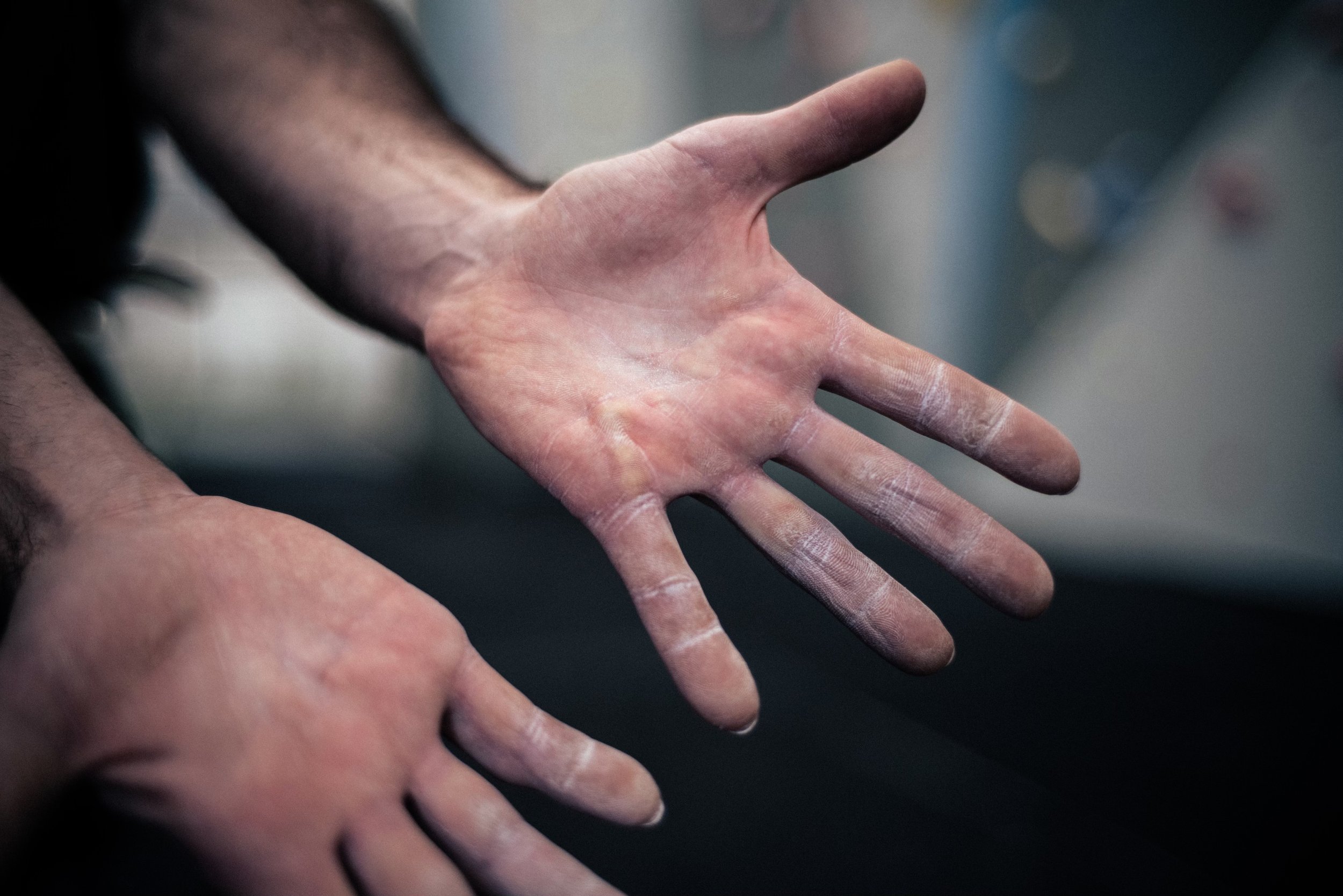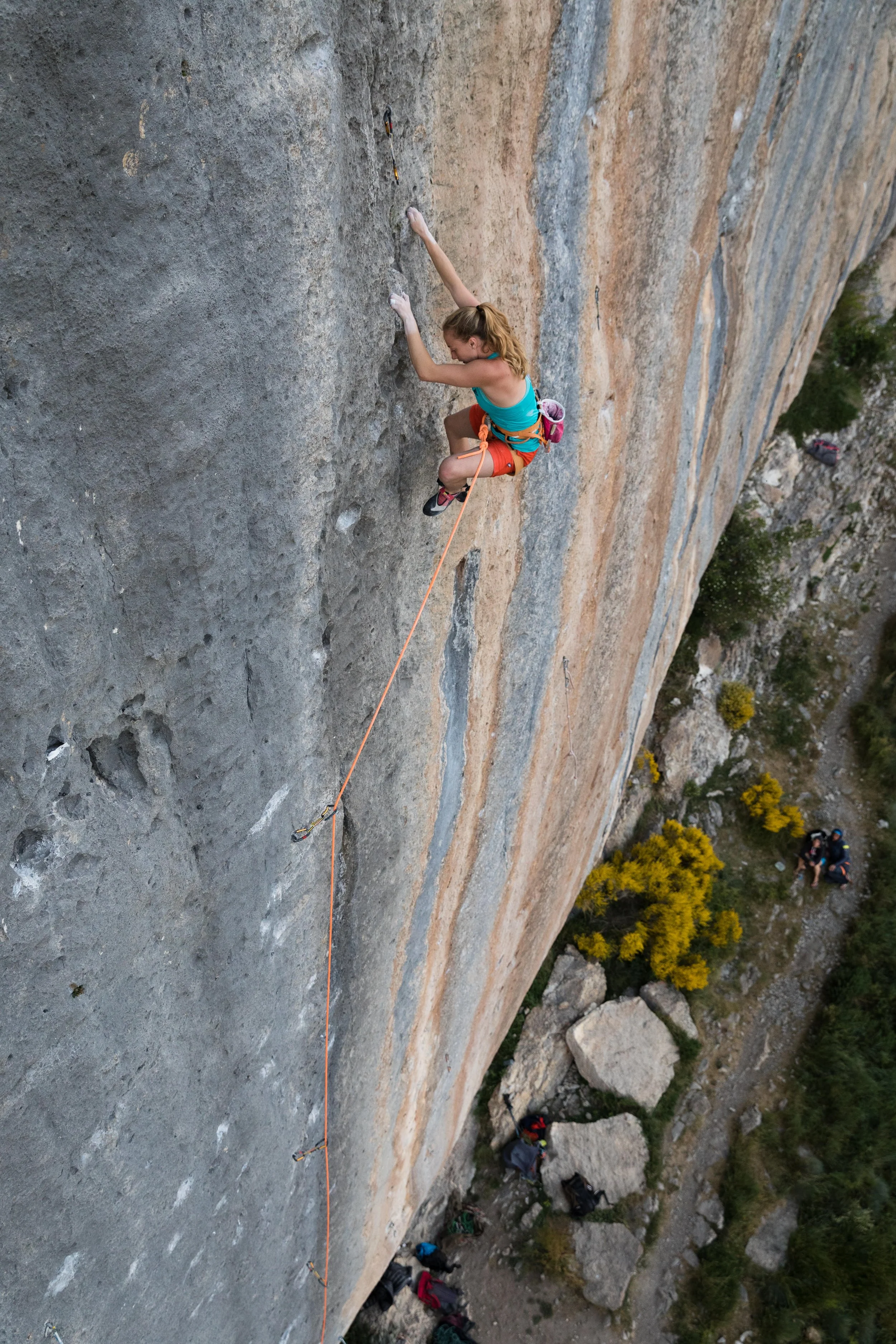Dupuytren’s Contracture and Rock Climbing
Guest Article Written By: Michaela Kiersch, OTD & Professional Climber
Generally, rock climbers experience a variety of sport-specific injuries and health conditions. Many of these conditions are localized to the hand, a region of the body that undergoes tremendous amounts of stress while rock climbing. In particular, rock climbing increases the risk of developing Dupuytren’s contracture, a thickening and tightening of the tissues in the palm of the hand (1, 4).
Photo by Edwin Teran
Dupuytren’s contracture is a progressive pathological condition concerning the palmar fascia of the hand. Essentially, increased collagen builds into cords within the palm, shortening the tissues and eventually causing disability through decreased range of motion and strength. This pathological process is hypothesized to be an inflammatory response to increased stress on the tissues, such as those caused by rock climbing (2). Dupuytren’s contracture is hereditary and typically develops in men over the age of 60 (5). However, rock climbers may develop Dupuytren’s contracture in their early 20’s due to repetitive stress to the palmar fascia (1).
Dupuytren’s contracture primarily impacts the ring and small fingers of the hand. Identifying Dupuytren’s contracture is dependent on several factors, including condition severity. Individuals with Dupuytren’s contracture most often will notice hardened nodules or thickened cord-like structures on the palm of the hand below the ring and small fingers. In later stages, decreased range of motion of these fingers and decreased strength may also occur. Rock climbers may experience pain while grabbing climbing holds that exert pressure to the impacted area. Additionally, rock climbers may experience weakness on the affected side while climbing.
Michaela Kiersch climbing Femme Noir (5.12d) in Céüse, France.
Photographer: Edwin Teran
Rock climbers are not only more likely to develop Dupuytren’s contracture but are also at risk for increased condition severity compared to the general population (1, 4). Dupuytren’s contracture is not preventable and evidence to support stretching and strengthening exercises in response to this condition is extremely limited. Fortunately, there are several treatment options available to address Dupuytren’s contracture.
Surgical intervention in the form of a fasciectomy has been the most common treatment historically, although surgical approaches vary depending on contracture severity (3). This approach essentially removes the offending tissues in order to provide relief of symptoms. Surgical interventions are commonly accompanied with physical or occupational therapy for orthosis fabrication and range of motion exercises. Complications from surgery have been recorded between 3.6% - 39.1% (2) and may include pain, nerve injury, delayed wound healing, and recurrence of Dupuytren’s contracture (3).
Less invasive approaches are becoming increasingly common for treatment of Dupuytren’s contracture and most frequently involve injections of collagenase clostridium histolyticum in order to dissolve the built up collagen cords (3). This approach is equally as effective as surgical intervention and also allows individuals to return to using their hands for daily activities within a few days compared to nearly a month following surgery. However, it is important to note that recurrence of Dupuytren’s contracture is common with both approaches. Surgical intervention results in slightly decreased recurrence when compared to injections, however, the number of times surgery may be performed on the hand is limited whereas injections may be performed as needed (2, 3). Treatment may be delayed if an individual does not experience functional limitations as a result of Dupuytren’s contracture.
In summary, Dupuytren’s contracture may be relatively mild with few functional limitations in the early stages. Normal rock climbing activities are usually able to be continued during this period. However, it is important to note that Dupuytren’s contracture is progressive and may worsen over time. These changes usually warrant a visit to your healthcare provider to determine the best plan of care and whether further treatment is necessary.
Grassroots’ take on Dupuytren’s Contracture
Written By: Esther Smith, DPT, Cert. MDT and Mali Pfinsgraff, SPT
Once the progression of Dupuytren’s begins, conservative treatment cannot reverse the condition, but occupational and physical therapy can be helpful in restoring function, strength, and mobility.
Check out our video featuring Esther Smith, DPT, Cert. MDT giving Edwin Teran giving a comprehensive tutorial on potential strategies for self care:
Self massage techniques with an Armaid
Pen rolling
Banded exercises
Wrist isometrics
Density hangs
If you are concerned that you may be developing Dupuytren’s, we recommend seeking out a licensed physical therapist or occupational therapist in your area for diagnosis and treatment recommendations. These are some treatment strategies that you can explore with your provider:
Ultrasound and heat can be very beneficial in the early stages of of the progression to prevent adhesions
Splinting to slow the progression
Steroid injections can be helpful for pain relief
References
Logan, A. J., Mason, G., Dias, J., & Makwana, N. (2005). Can rock climbing lead to Dupuytren’s disease? British Journal of Sports Medicine, 39(9), 639-644. https://doi.org/10.1136/bjsm.2004.015792
Mella, J. R., Guo, L., & Hung, V. (2018). Dupuytren’s contracture: An evidence based review. Annals of plastic surgery, 81(6S), S97-S101. https://doi.org/10.1097/SAP.0000000000001607
Naam, N. H. (2013). Functional outcome of collagenase injections compared with fasciectomy in treatment of Dupuytren's contracture. Hand, 8(4), 410-416. https://doi.org/10.007/s11552-013-9540-7
Schoffl, V. R., & Schoffl, I. (2007). Finger pain in rock climbers: Reaching the right differential diagnosis and therapy. Journal of sports medicine and physical fitness, 47(1), 70.
Yang, K., Gehring, M., Eddine, S. B. Z., & Hettinger, P. (2019). Association between stenosing tenosynovitis and Dupuytren’s contracture in the hand. Plastic and Reconstructive Surgery Global Open, 7(1). https://doi.org/10.1097/GOX.0000000000002088



